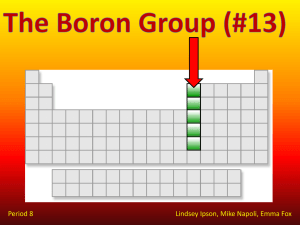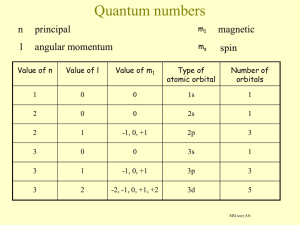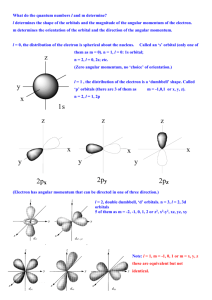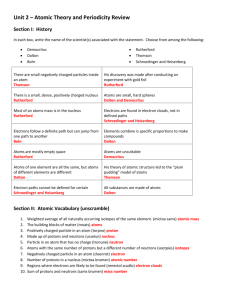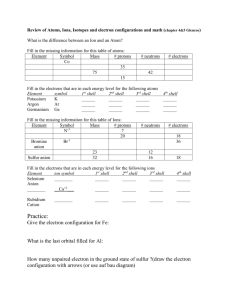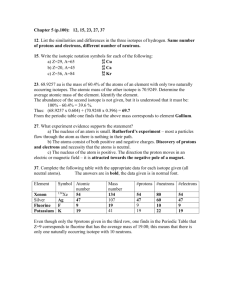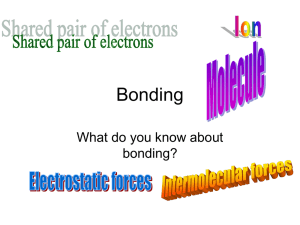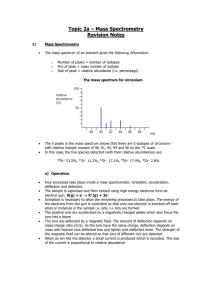Some Possible Homework #6 Problems…
advertisement
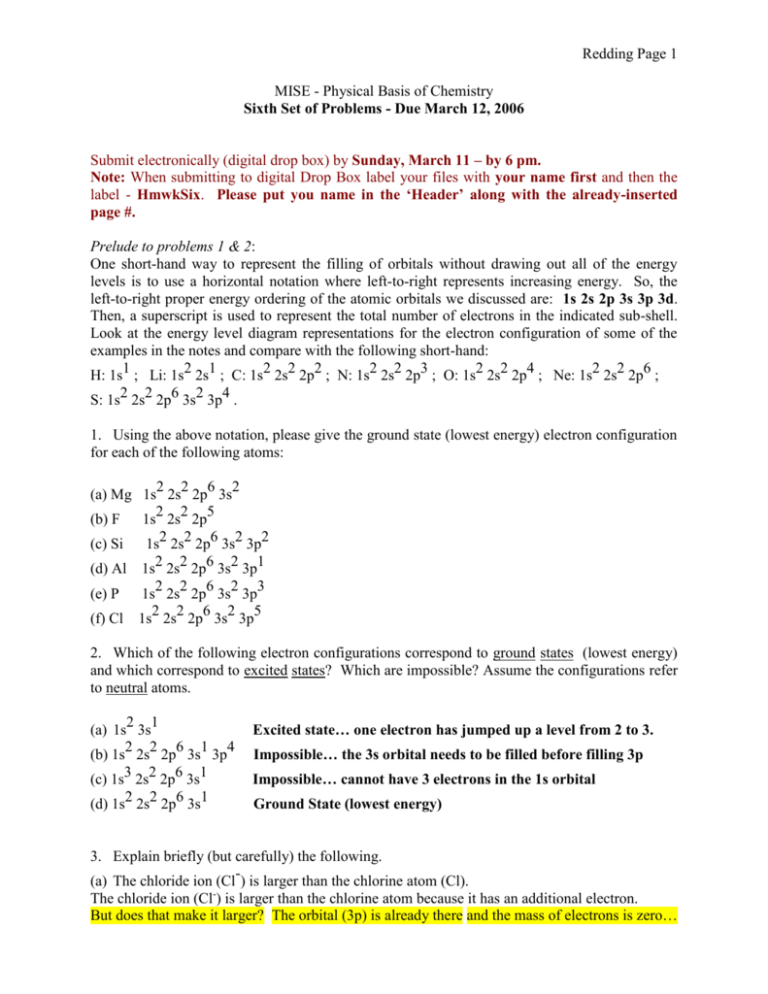
Redding Page 1 MISE - Physical Basis of Chemistry Sixth Set of Problems - Due March 12, 2006 Submit electronically (digital drop box) by Sunday, March 11 – by 6 pm. Note: When submitting to digital Drop Box label your files with your name first and then the label - HmwkSix. Please put you name in the ‘Header’ along with the already-inserted page #. Prelude to problems 1 & 2: One short-hand way to represent the filling of orbitals without drawing out all of the energy levels is to use a horizontal notation where left-to-right represents increasing energy. So, the left-to-right proper energy ordering of the atomic orbitals we discussed are: 1s 2s 2p 3s 3p 3d. Then, a superscript is used to represent the total number of electrons in the indicated sub-shell. Look at the energy level diagram representations for the electron configuration of some of the examples in the notes and compare with the following short-hand: H: 1s1 ; Li: 1s2 2s1 ; C: 1s2 2s2 2p2 ; N: 1s2 2s2 2p3 ; O: 1s2 2s2 2p4 ; Ne: 1s2 2s2 2p6 ; S: 1s2 2s2 2p6 3s2 3p4 . 1. Using the above notation, please give the ground state (lowest energy) electron configuration for each of the following atoms: (a) Mg 1s2 2s2 2p6 3s2 (b) F 1s2 2s2 2p5 1s2 2s2 2p6 3s2 3p2 (d) Al 1s2 2s2 2p6 3s2 3p1 (e) P 1s2 2s2 2p6 3s2 3p3 (c) Si (f) Cl 1s2 2s2 2p6 3s2 3p5 2. Which of the following electron configurations correspond to ground states (lowest energy) and which correspond to excited states? Which are impossible? Assume the configurations refer to neutral atoms. (a) 1s2 3s1 (b) 1s2 2s2 2p6 3s1 3p4 Excited state… one electron has jumped up a level from 2 to 3. (c) 1s3 2s2 2p6 3s1 (d) 1s2 2s2 2p6 3s1 Impossible… cannot have 3 electrons in the 1s orbital Impossible… the 3s orbital needs to be filled before filling 3p Ground State (lowest energy) 3. Explain briefly (but carefully) the following. (a) The chloride ion (Cl-) is larger than the chlorine atom (Cl). The chloride ion (Cl-) is larger than the chlorine atom because it has an additional electron. But does that make it larger? The orbital (3p) is already there and the mass of electrons is zero… Redding Page 2 Do I need further explanation? + (b) The sodium atom (Na) is larger than the sodium ion (Na ). The sodium atom is larger than the sodium ion because it has not lost an electron. The sodium atom has one less electron. But does that make it larger? The orbital is already there and the mass of electrons is zero… 4. Use electronegativities to classify the following substances as either mainly covalent (MC) or mainly ionic (MI) according to the character of their bonds. [Note: For the molecules with more than 2 atoms, the first atom is central, i.e., all of the subsequent atoms are attached to the first atom. For example in CCl4 there are four C-Cl bonds ; in PBr3 there are three P-Br bonds, etc.] CCl4 … .7 MC BaBr2 … 2.1 MI CO2 … 1.0 MC SiC … .6 MC PBr3 … .8 MC I2 … 0 Purely Covalent NLi3 … 2.0 MI Question: This applies to all, but most easily asked here… Do you multiply 1.0 (electronegativity for Li) by 3 because there are 3 atoms, or just subtract 1.0? If you multiply by 3, the molecule is purely covalent, but if 1.0 is used, it is ionic. CaO … 2.5 MI 5. Underline the substance in each of the following series which has the indicated property. (a) Largest atomic radius: As , Se , K , Ca . (b) Largest atomic radius: Kr , Ne , Xe , Ar , He (c) Smallest radius: Al+3 , In+3 , B+3 , Ga+3. (e) Greatest electronegativity: S, Cl, As , Mg , Cs . (f) Greatest number of unpaired electrons: Be , B , C , N . (g) Greatest number of unpaired electrons: Na+1 , Cl1 , Ne , Na . (h) Smallest radius: Al+3 , Al+2 , Al+1 , Al . 6. Lewis structures & Self-Study The isocyanate ion consists of one atom each of carbon (C), nitrogen (N), and oxygen (O). This ion has a -1 net charge (i.e., one extra electron). Below are some Lewis structure candidates (labeled 1 through XII as shown). Notice that some of the candidates have the atoms rearranged. These are termed isomers. The structures with N in the center constitute one isomer (I, II, & III), those with C in the center constitute a second isomer (IV, V, VI, VII, VIII, & IX), and those with O in the center, a third isomer (X, XI, & XII). Redding Page 3 The various versions of each isomer – with different electron arrangements (provided they are valid Lewis structures) are termed resonance structures. Thus, below are depicted some candidates for resonance structures for the three different isomers of the isocyanate ion. Note however the parenthetical remark (in red). Some of the proposed structures are not valid (such as: incorrect number of total valence electrons, violation of octet rule, etc.). Your mission then is the following: (a) Carefully analyze each structure (I through XII) to see if they are valid Lewis structures. If not, for any structure that you feel is invalid, refer to it by its Roman numeral and list the reason(s). IV: There are too many electrons. (20e-… should be 16e-) V: This structure violates the octet rule (C has 10e-) VI: This structure violates the octet rule (C has 10e-) (b) For any valid structure, assign formal charges (FC) to each atom in the structure. (Please refer to Lecture 6 notes page 9 for details). Express each answer as follows: Structure xxx (give Roman number): FC on C = xx (give FC) , FC on N = xx (give FC), FC on O = xx (give FC). I: FC on C = -2, FC on N = +1, FC on O = 0 II: FC on C = -1, FC on N = +1, FC on O =-1 III: FC on C = -3, FC on N = +1, FC on O =+1 VII: FC on C = 0, FC on N = -1, FC on O =0 VIII: FC on C = 0, FC on N = 0, FC on O =-1 IX: FC on C =0, FC on N = -2, FC on O =+1 X: FC on C = -2, FC on N = -1, FC on O =+2 XI: FC on C = -3, FC on N = 0, FC on O =+2 XII: FC on C = -1, FC on N = -2, FC on O =+2 (c) Continue to the lecture notes referred to above to learn what constitutes a “good” Lewis structure based upon formal charge (so-called) “valence strain”). Then, based upon this analysis, determine the “best” structure(s) (by Roman numeral(s)). Explain why. If you feel that more than one than structure is equally good, be sure to explain why. The best isomer structures would be VII and VIII because they contain the lowest build up on any one atom. They have two atoms with an FC of zero and one with an FC of -1. To take it a step further, the best resonance structure would be VIII because it has the negative formal charge on the atom with the highest electronegative atom, which is Oxygen. Redding Page 4 •• O •• I •• •• N •• O •• O •• N •• - •• C •• C N O VIII C XI •• - N •• N •• IX O - VI C •• N C O XII •• N •• •• X O •• O N •• •• •• •• •• C C C •• •• N •• VII •• - •• C - N - III •• •• •• •• O II V IV •• O •• C •• C •• •• •• •• •• O •• - N •• •• C •• •• N •• •• •• - •• O •• -


